Power suits, bright animal prints, and fanny packs — those 80s relics that you either tossed out 30-plus years ago, or lost somewhere in the dark depths of your closet — are (regrettably?) all back in style. But it’s not just the fashion of that era that’s been resurrected: “Satanic panic,” the hysteria over devil worship that consumed the nation during the era, seems to be making a comeback, too.
Just listen to some of today’s conservative politicians, pundits, and religious leaders, and you’d believe that the devil is alive and well and lurking in the heartland. Satan is now a reliable talking point for some in positions of power, says Joseph Uscinski, Ph.D., a professor of political science at the University of Miami, who studies conspiracy theories and how they proliferate.
The devil can be found at the core of the liberal agenda, as right-wing politicos like Congresswoman Marjorie Taylor-Greene assert. And one of the fundamental tenets of QAnon is that Democratic leaders are engaged in a conspiracy to kidnap children and use their blood in Satanic rituals. Satan was also allegedly the dark force behind a seemingly harmless monument known as “America’s Stonehenge.” Once a quirky roadside attraction, the Georgia Guidestones were mysteriously blown up this summer after a gubernatorial candidate called them “Luciferian.”
Belief in Christianity has been declining throughout the U.S. for decades. So what’s behind what feels like a growing fear and fixation with the devil? It’s a phenomenon that’s hard to understand, even for the scholars who studied the moral panic that swept through America in the 80s and 90s.
The Trump factor
The backlash to the counterculture of the 60s was one thing that helped fuel the fear of Satanism that began spreading in the 80s, says Sarah Hughes, Ph.D., the author of American Tabloid Media and the Satanic Panic, 1970-2000. At the time, she explains, there was a collective push to return to the “traditional” family values defined by the Leave it to Beaver ideal. The rise of Jerry Falwell Sr. and other powerful evangelicals of the era, who preached a fire-and-brimstone style of sermon filled with allusions to demonic forces and evil hiding in America’s suburbs, helped feed this fervor.
These leaders helped shape a radically polarized view of the world adopted by millions of religious Americans. Falwell framed anything other than the conservative policies he supported as an affront to Christianity, and cast the divide between Democrats and Republicans not as a difference of opinion, but rather as a “battle for America’s soul,” Baylor University professor Samuel Perry, Ph.D., writes in The Conversation. The Christian right coalesced to create the moral majority, a political bloc that held a tremendous amount of sway and ultimately delivered the White House to Ronald Reagan.
“We are fighting a holy war,” Falwell told his congregation in 1980. “What’s happened to America is that the wicked are bearing rule. We have to lead the nation back to the moral stance that made America great.”
Sound familiar?
Throughout his 2016 campaign and his presidency, Donald Trump borrowed heavily from Reagan’s playbook, Dr. Hughes says. He seized on a backlash that had been building against social issues like the trans-rights movement or the legalization of gay marriage to win the support of the Christian right. He even leaned heavily on Falwell’s son, Jerry Falwell Jr. to burnish his image among believers. And Trump met with other controversial religious figures, including one Florida televangelist who told his worshippers Hollywood was a hotbed of Satanism and human sacrifice.
“These people are full of the devil,” Rodney Howard-Browne said in a 2017 sermon. “They have already given their soul to the devil… These people go through seances, these people drink blood, these people sacrifice children.”
Support from politicians has only helped push these views into the mainstream and emboldened other leaders like Greene to embrace them to bolster her base. But Trump has had another curious effect on the zeitgeist, says Dr. Uscinski: “He sort of opened up our politics to a very anti-establishment way of thinking, and he’s brought a lot of people into his coalition who just want to blow the system up.”
QAnon and the devil
That yearning to topple a system that’s been corrupted (to “drain the swamp,” so to speak) is what’s behind QAnon’s allure. The once-fringe online conspiracy theory sprouted in online circles and has since convinced a sizable number of Americans that the world is run by a cabal of Satan-worshiping pedophiles, whose ranks include President Biden, Hillary Clinton, and other high-profile Democrats. It’s led followers to storm the Capitol and convinced hundreds that John F. Kennedy Jr., who’s been dead for over 20 years, would return to become Donald Trump’s V.P.
Despite how bizarre that all may sound, one study indicates that 16 percent of Americans buy into the theory. And many of the experts we spoke to aren’t all that surprised: David Frankfurter, a professor of religion at Boston University whose book Evil Incarnate explores the long history of Satanic panic, says that Americans have been “fascinated with the idea of both the occult and Satanism for a good century” or longer.
Whether 300 years ago in Salem, Massachusetts, or 40 years ago, these moral panics have tended to resurface again and again. As with QAnon, they often spring from a fear of secretive institutions (a la “the deep state”), says Bill Ellis, Ph.D., a professor emeritus at Pennsylvania State and the author of Raising the Devil. He points to the frenzy of the late 18th Century over the Illuminati, the secret society thought to have designs on eradicating Christianity. Or The Protocols of the Elders of Zion, a book that claimed Jewish leaders were plotting world domination by manipulating the economy and controlling the media, a conspiracy theory that contributed to the anti-Semitism that raged through Europe.
“I like to refer back to Ecclesiastes, ‘What has been will be again, what has been done will be done again; there is nothing new under the sun,” Dr. Ellis says.
Conspiracy theories tend to spread swiftest during times of crisis or social unrest. That’s because we crave simple, tidy explanations for what are often complex global issues — like climate change or a massive pandemic. At least in the West, where Christian mythology is baked into the culture, Satan — as the ultimate source of chaos and evil — becomes a convenient scapegoat.
“The devil has always been the author of these conspiracy stories,” Dr. Ellis says.
A resurgent Satanic panic?
A major component of the Satanic panic of the 80s was the fear that children were falling victim to these hidden cults. That wave partially sprang from a 1980 memoir called Michelle Remembers, whose author claims to have been sexually abused by members of the Church of Satan. The shocking allegations were widely debunked, but the book still became a bestseller and sparked dark rumors that Satanists had infiltrated daycare centers to commit unspeakable acts against children.
For more than a decade, what amounted to witch hunts took place across the U.S.: Wild claims of satanic ritual abuse were being cast against ordinary people, many of whom were prosecuted. In one case, the McMartin trial, the owners of a California preschool were accused of building secret underground tunnels for ritual ceremonies, flushing children down toilets, being able to turn into witches and fly, and other outlandish deeds. All the charges were ultimately dropped in the criminal trial, which still stands as the longest and most costly in California history.

Part of what sustained this manic cycle for so long was that a network of social workers, therapists, and law enforcement agents were promoting themselves as “so-called experts” in the occult, Dr. Frankfurter says.
“These were down-to-Earth people who you would ordinarily trust,” who were pointing their fingers at others in their communities and condemning them as monsters, he says.
That particular phenomenon isn’t something Dr. Frankfurter sees repeating itself in the current context, partly because the social apparatus just isn’t there. It’s not people in small towns turning against each other; it’s faceless agents online making accusations against high-ranking politicians and movie stars.
“It’s becoming more of a national issue,” says Dr. Uscinski, “where before it was more localized.”
But there are signs that a Satanic panic is making inroads in our public institutions. The largest teachers union recently alerted its members to the rapid rate at which QAnon adherents are winning seats on local school boards. Just this month, a high-school student was forced to defend her high-school mural against angry parents who claimed she had hidden depictions of the devil and witchcraft in the piece.
And in Utah, an investigation was opened this summer into claims of “ritualistic child sexual abuse” occurring throughout the state. It’s an episode that bears an unsettling resemblance to the panic of the 80s and even ensnared the Utah County Attorney, who held a press conference to deny allegations that he and his wife had murdered and cannibalized kids.
“There’s a lot of talk online about devil worship at the highest levels of power, and who knows what that could breed?” Hughes says. “I do see that there’s potential for this to rise again.”









